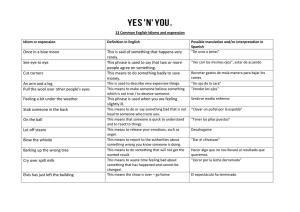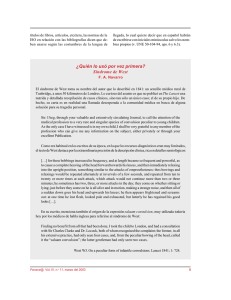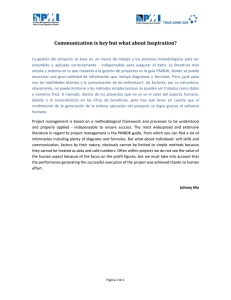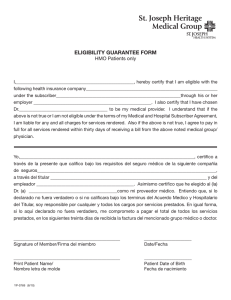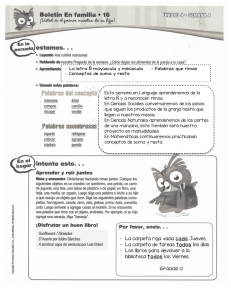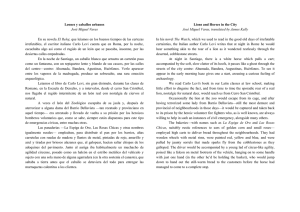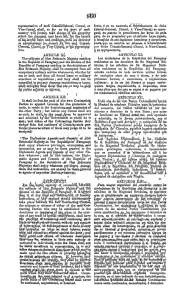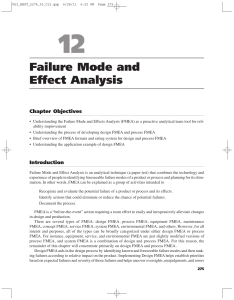this PDF file - Journal of Maritime Research
Anuncio
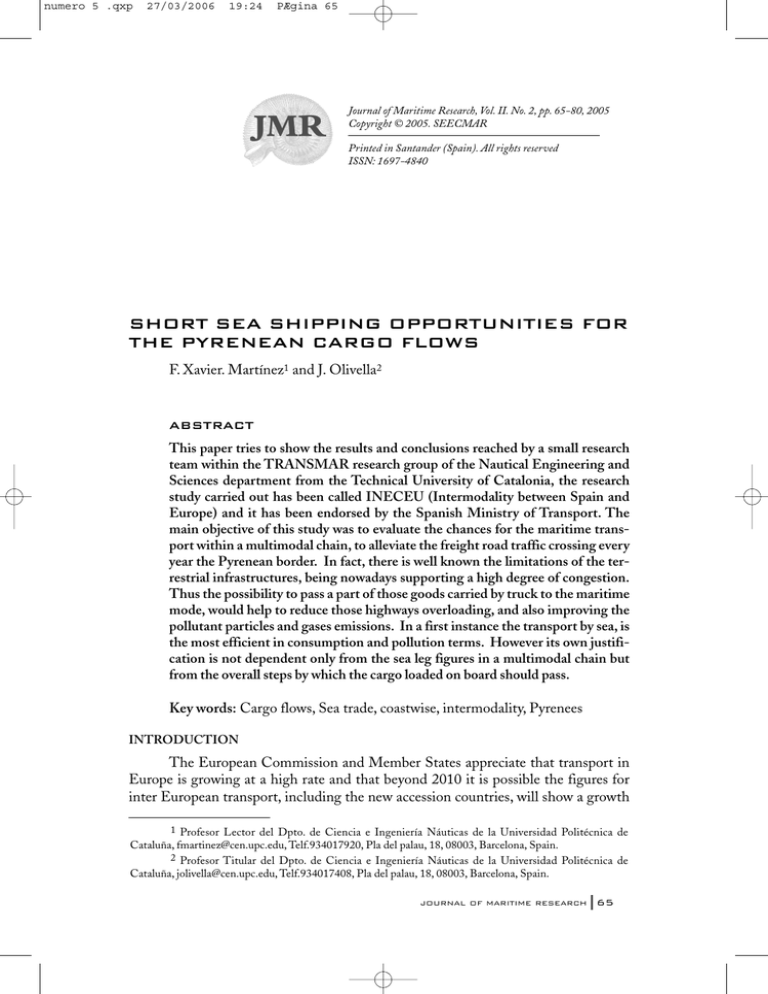
numero 5 .qxp 27/03/2006 19:24 PÆgina 65 Journal of Maritime Research, Vol. II. No. 2, pp. 65-80, 2005 Copyright © 2005. SEECMAR Printed in Santander (Spain). All rights reserved ISSN: 1697-4840 SHORT SEA SHIPPING OPPORTUNITIES FOR THE PYRENEAN CARGO FLOWS F. Xavier. Martínez1 and J. Olivella2 ABSTRACT This paper tries to show the results and conclusions reached by a small research team within the TRANSMAR research group of the Nautical Engineering and Sciences department from the Technical University of Catalonia, the research study carried out has been called INECEU (Intermodality between Spain and Europe) and it has been endorsed by the Spanish Ministry of Transport. The main objective of this study was to evaluate the chances for the maritime transport within a multimodal chain, to alleviate the freight road traffic crossing every year the Pyrenean border. In fact, there is well known the limitations of the terrestrial infrastructures, being nowadays supporting a high degree of congestion. Thus the possibility to pass a part of those goods carried by truck to the maritime mode, would help to reduce those highways overloading, and also improving the pollutant particles and gases emissions. In a first instance the transport by sea, is the most efficient in consumption and pollution terms. However its own justification is not dependent only from the sea leg figures in a multimodal chain but from the overall steps by which the cargo loaded on board should pass. Key words: Cargo flows, Sea trade, coastwise, intermodality, Pyrenees INTRODUCTION The European Commission and Member States appreciate that transport in Europe is growing at a high rate and that beyond 2010 it is possible the figures for inter European transport, including the new accession countries, will show a growth 1 Profesor Lector del Dpto. de Ciencia e Ingeniería Náuticas de la Universidad Politécnica de Cataluña, fmartinez@cen.upc.edu, Telf.934017920, Pla del palau, 18, 08003, Barcelona, Spain. 2 Profesor Titular del Dpto. de Ciencia e Ingeniería Náuticas de la Universidad Politécnica de Cataluña, jolivella@cen.upc.edu, Telf.934017408, Pla del palau, 18, 08003, Barcelona, Spain. JOURNAL OF MARITIME RESEARCH 65 numero 5 .qxp 27/03/2006 19:24 PÆgina 66 SHORT SEA SHIPPING OPPORTUNITIES FOR THE PYRENEAN CARGO FLOW of over 80% in volume, and unfortunately these values will be absorbed mostly by road transport. Still around 45% of European Union foreign trade is still carried by road and is consequently conditioned by traffic congestion or high fuel consumption, implying disadvantages related to pollution and safety. Meanwhile up to 40% of the before mentioned volume is carried by short sea shipping. Short Sea Shipping in European waters has been considered by national and European governments as one of the most feasible ways to alleviate the congestion that gets worse every day on the roads and highways across Europe. The European Union has gone one step further by approving an overall budget of 740 millions € over 7 years (from 2007 to 2013) for a programme that will include funding for TEN – T,[1] dedicated aspects of Galileo and Marco Polo programmes, for the development of means of transport other than road transport. The geography. From 1991 to 2000, transport volumes increased between the Iberian Peninsula and other EU states, having affected all the means of transport in the following percentages; 40% for road, 41% for shipping and up to 32% for rail, even though it decreased in general terms. The share of each means of transport favours road with 52%, shipping 43% and rail only 5%. In 1998 the volume of cargo haulage by train was only 4.7 millions of metric tonnes, and for combined transport (ferroutage) this amounted to 2.4 millions of metric tonnes, but up to 56.9 millions of metric tonnes by truck during the same year. When talking about light and specific vehicles the trends have shown an increase of up to 33% in 10 years among the two means. The previous figures translated to absolute numbers bring us up to 17,000 heavy vehicles passing the Pyrenean border in the year 2000 [2]. The permeability of this mountain range, has been discussed in different fora such as the Comunidad de Trabajo de los Pirineos [3], an organisation that represented both sides of this natural barrier whose main objectives were to identify as the main problem, the lack of enough transport networks, linking the Iberian peninsula and Europe. Figure 1. The Pyrenean border during the year 2002 and the communications network Source: Conseil Regional Midi Pyrenées, year 2004. 66 Volume II. Number 2. year 2005 numero 5 .qxp 27/03/2006 19:24 PÆgina 67 F. XAVIER MARTÍNEZ, J. OLIVELLA Existing communication links. The ways currently used for carrying goods from one side of the Pyrenean border to the other are mainly road accesses as follows: 1. Donostia-Irún (A-8) to Biriatou-Bayonne (A-63). 2. Iruña-Roncesvalles (N-135) to St. Jean Pied de Port-Ortez (D-933) (a highway is intended). 3. Iruña-Salies de Béarn or Transnavarra highway just opened. 4. Huesca Jaca-tunnel of Somport (N-330) to Oloron St Marie-Pau (N-134). 5. Ainsa tunnel of Bielsa (A-138) to Lannemezan (N-125) 6. Lleida-tunnel of Vielha (N-230) to Pont del Real-St. Béat (N-125) towards Toulouse. 7. Barcelona-Puigcerda (A-18, C-16, N-260) to Bourg Madame-FoixToulouse (N-20). 8. Barcelona-La Jonquera (A-7) to Le Boulou-Perpignan (A-9). Although there seems to be plenty of choice, the volume is, in practice, concentrated in 90% travelling throught the two coastal highways (1 and 8) because of the higher quality roads. Regarding the railway, the lines in service are mainly the two coastal passes and one minor central passage: 1. Donostia-Hendaya to Bayonne. 2. Ripoll to La Tour de Carol-Foix. 3. Figueres-Portbou to Perpignan and connection to Céret. There is planned for the future the Canfranc Pyrenean passage (linking that city through a tunnel under the Somport with Oloron-Buzy in Béarn and Pau) that is in the region of Aragon and is being promoted to be considered as another choice. After the major work to be done, it will eventually be capable of dealing with up to 3 millions of tonnes per year. However, studies carried out [4] are confirming that the origin of the problem of overloading rests on the next points: 1. The railway network crossing the Pyrenees is limited to the 2 coastal passes that were built 125 years ago. 2. The different rails width. 3. Blockage at the frontier due to road congestion. 4. The increase of the flow of goods crossing the border. In 1998 up to 14,000 trucks per day and this rate is on the increase, being 17,000 in 2002, and 19,300 in 2005. The capacity of land carriage is complimented by air traffic with a minor impact in terms of volume, and also the shipping link from commercial ports in Spain with others in Europe. JOURNAL OF MARITIME RESEARCH 67 numero 5 .qxp 27/03/2006 19:24 PÆgina 68 SHORT SEA SHIPPING OPPORTUNITIES FOR THE PYRENEAN CARGO FLOW INTRA EUROPEAN COASTAL TRANSPORT If a European coastal trade may be defined as that carried out within the European geographical limits and even reaching the sea areas near to the European coasts, it should include the short sea trade. Taking a quick look into the last technical advances in the marine sector, we identify three basic pillars on which modern shipping rests; bulk, container and rolling cargoes. All of them are so specific that they have particular features regarding their logistic chains and performances [5]. We should consider bulk transportation of mass freight where the ship is the most favourable option compared to the truck. However, when we consider the container and Ro/Ro services available we can see that for regular traffic there are opportunities for a steady flow of cargo for road to sea and vice versa. There is a future to be considered when talking about container traffic because the trend of reducing port calls for the larger container carriers entering each year into a few hub ports, should be backed by frequent feeder services that are spread out and that should be included in the short sea shipping European trade. Ro/Ro services have also been firmly placed as a link between insular territories and the mainlands as communications links within closed seas and generally on the basis of a fast transhipment of cargo loaded on trucks, trailers or specific platforms. There are true cabotage and short sea trades, not only in Europe as the paradigmatic case of Grimaldi Napoli, but in our country mainly Grupo Boluda with Naviera Pinillos, Vapores Suardíaz or Contenemar. However a brief look will confirm the real chances that short sea services have in Europe, provided the future funding and regulations are approved for their endorsement. Superfast ferries are Greek owned, previously serving in the Adriatic and Baltic seas and they recently opened a service between Zeebrugge and Rosyth in Scotland, therefore avoiding the long trip for trucks from the North of Great Britain. Grimaldi Napoli, have consolidated its Barcelona-Genoa line and a few months ago introduced the Barcelona-Civitavecchia and Valencia-Civitavecchia services, with successful results. Brittany Ferries and P&O ferries have provided services in the English Channel for a long time now and it has reinforced its services between Spain and Great Britain. The Pont Aven is the latest ferry presented last October by Brittany Ferries. Naviera Pinillos from Group Boluda, using container and Ro/Ro ships, is serving Canary Islands traffic with the mainland but also maintains services from the peninsula and islands to Italy, Great Britain or Mauritania. Also Contenemar, serves certain container traffic, not only with Spanish archipelagos but also with the Atlantic coast of Africa, Livorno, Civitavecchia or Southampton, Flushing and Zeebrugge together with ports in the eastern Mediterranean. Cobelfret’s Belgian owner, have most of their ships flagged in Luxemburg and is a solid provider of traffic between mainland ports and the UK, but it is an example of a transport provider for the Swedish paper manufacturer Stora-Enso. And last but not least we ought to note the Spanish owner Group Suardiaz providing service with 16 68 Volume II. Number 2. year 2005 numero 5 .qxp 27/03/2006 19:24 PÆgina 69 F. XAVIER MARTÍNEZ, J. OLIVELLA car carriers, 13 ships being involved in regular lines to Flushing, Zeebrugge, Southampton, Italy or eastern Mediterranean. The last service opened in November is Flushing-Zeebrugge-Santander-Bilbao. There are examples of fixed contracts such as the one signed with the NATO for serving in any required traffic in Europe, or the GEFCO (Peugeot-Citroen) contract linking Vigo with Saint Nazaire and Toulon, that is being served by Trasmediterranea. THE EUROPEAN TRANSPORT NETWORKS The European Commission has promoted a set of measures directed to coordinate and unify European transport objectives, avoiding the different legislation distortions that would have a negative influence on and increase the price of cargo and passengers transport. We could look at October 1992 when the Maritime Industries Forum recommended the: “promotion of the short distance and multi modal maritime transport, facing the problems in the use of the maritime transport as a challenge to oppose road transport”. In 1994, the Essen European Council, adopted 11 of 14 priority projects regarding transport resources and in 1996, the European Parliament and Council, drew up the future guidelines for the trans European transport networks towards the year 2010. In 2001, the decision was revised in order to admit maritime and inner ports into the transport policy. In fact the Trans European Transport Network or TEN is a concept formulated in some of the above mentioned European documents that originated in the Maastricht Treaty, which requires the Community to contribute to the creation and development of such transport and communication networks. Further in September of 2001 and triggered as a response to the Mont Blanc accident of 1999, the European Commission presented the “The European transport policy towards 2010: time to decide” White Paper, that posed among its priorities, to look for an alternative to the congested road passages and mainly those of the Alps and the Pyrenees. The coastal services are initially very difficult to be started up and being conscious of this, the EC proposed to identify and help them through initiatives such as the Marco Polo and previously the PACT structural funds, focusing on the establishment o the new short trade shipping lines. During the month of June 2002 in Gijón, the EU Transports Ministers informal meeting was held, where it was decided to draft a plan for promoting coastal shipping transport. That concluded in the 14 points programme for stimulating short sea trade, with the sea highways concept being among them once again. Some of the first reactions to the Gijón declaration were two French Parliamentary reports called François Liberti in 2002 and Henri de Richemont [6] in 2003. This last report proposed policies to promote Ro/Ro services in French ports, which are justifiable although there are a lack of key items (capitalisation, inadequate offer or absence of industrial dedicated traffic) that are expected to be facilitated by the local authorities. JOURNAL OF MARITIME RESEARCH 69 numero 5 .qxp 27/03/2006 19:24 PÆgina 70 SHORT SEA SHIPPING OPPORTUNITIES FOR THE PYRENEAN CARGO FLOW The van Miert Group, led by the ex EC transport commissioner Mr. Karel van Miert, carried out a study of over 100 proposed projects [7] by the member states, in order to select the most urgent ones and to distribute available funds. This study kept in mind factors such as the technical and finacial ones, together with their agreement to European transport policies as proposed in the white paper, funding possibilities, together with the real chances to be carried out. 22 priority projects were chosen including the sea highways and the 5 projects known as Essen [8], close to their finalisation. Those projects should be started before the year 2010, whilst the European Commission carries out a detailed impact study and proposes a revision of the community guidelines for the development of transport networks [9]. The van Miert report was further developed when the European Parliament Transport Committee passed, on 17 February 2004, the preliminary report by Philip Bradbourn on the Communitarian directives for TEN-T development. The European Commission confirmed the decision in March keeping in mind that this should be a tool for improving the articulation of the 25 members Europe and also providing for the development of the sea highways, simplifying frontier procedures and ensuring that such highways are free of bottlenecks and really are promoting alternatives such as sea transport for the regular bulk trades. The case of Spain is a good example as it is a peripheral country that would suffer to a greater extent any lack of infrastructures. The term “sea highways” are defined in the van Miert report presented in Brussels, establishing up to four: 1. Baltic (link between Baltic and central-north European states). 2. Atlantic (link between the Iberian peninsula, Ireland and the North Sea). Source: Rete Autostrade Mediterranee SpA, year 2004. Figure 2: Map showing some of the van Miert report selected projects. 70 Volume II. Number 2. year 2005 numero 5 .qxp 27/03/2006 19:24 PÆgina 71 F. XAVIER MARTÍNEZ, J. OLIVELLA 3. West Mediterranean (link between the Adriatic sea with the Ionian sea reaching Cyprus). 4. East Mediterranean (link between Spain, France, Italy and Malta connecting with the Atlantic highway). The sea highways intend to improve connection with the insular countries and those that are isolated because of the natural separation of the Alps or Pyrenees or the Baltic Sea. METHODOLOGY OF STUDY. The present study was divided into three main phases. The first one was focused on an analysis of existing projects and studies closely related to the same topic, available bibliography and gross data sources. A second phase intended to propose different sea corridors, depending on the cargo fluxes and volumes or the production and consumption centres in Spain. The points to be used as connections for moving the cargo were, of course, the ports along the Spanish coast, connected by two of the seaways previously mentioned. On a first analysis, the cargo to be transferred from road to sea would be mainly iron and chemical products, food stuff in general but mainly agricultural produce, largely concentrated in Andalusia and Levante coasts. This last would be easily packed in container units that facilitate intermodality. Once the chances for transferring the cargo to shipping had been evaluated, the high speed use was studied for certain kinds of perishable goods. The last and final step covered the criteria and recommendations arising from the previous two and studied the best port facilities that would provide safe and quick cargo transfer. The difficulties of those ports for connection to the main communications axes with the hinterland, the need for new open traffic corridors in certain ports or the railway links, need to demonstrate they are a viable alternative to the truck. Looking deeper into this, when the study had just started, some quite interesting European projects were identified, such as INSPIRE, SSS CA, EMMA [11] or even the most recent REALISE [12] inter alia, very close to the sea trade question of our study together with some others funded by SPC-Spain. [13]. Further, the viability analysis of the routes, was initiated using the figures provided by a permanent enquiry for trucks carried out by the French and Spanish governments in the Pyrenees. The following table shows the cargo volumes moved over the Spanish borders during 2003, using data from the governmental enquiry already mentioned. The total exchanged volumes were also classed by type of cargo and their origin or destination in Spain. So the parameters to be studied were: 1. Total volumes in export and import flows by truck, segregated by country. 2. Total volumes exchanged by truck, classed by groups of commodities. JOURNAL OF MARITIME RESEARCH 71 27/03/2006 19:24 PÆgina 72 SHORT SEA SHIPPING OPPORTUNITIES FOR THE PYRENEAN CARGO FLOW Source Spanish Ministry of Transport, year 2004 numero 5 .qxp Table 1: Cargo volumes moved over the Spanish borders. 3. Spain was divided into 5 different areas, representing each one homogeneous production and consumption zones and selecting some transport centres or logistic platforms.[14]. Some ports were selected in Spain depending on the kind of cargo mostly moved and the distance to the closest transport centres. DEVELOPMENT AND PRELIMINARY RESULTS. Once the largest exchange volumes were identified, the research group centred on these. Those countries were France, Germany and Italy. Regarding the groups of selected goods: 1. Agricultural products and live animals. 2. Foodstuffs and animal fodder (alcohol drinks and tobacco). 3. Ores, metal waste and products. 4. Chemicals. The two first would be very easily packed in unitized cells or cargo units, easing their inclusion in multimodal chains and a quick and efficient passage between different transport modes. We should clarify that the volumes and types of cargo are not coincident with the overall figures between Spain and Europe, but with the road exchanges. In the first case the largest party would of course be oil products, machinery, manufactured goods and transport equipment. Segregated by geographical areas, the production of agricultural products for exportation purposes come mainly from Andalusia and Valencia regions using 72 Volume II. Number 2. year 2005 numero 5 .qxp 27/03/2006 19:24 PÆgina 73 F. XAVIER MARTÍNEZ, J. OLIVELLA Valencia, Alicante, Cartagena, Almería or Huelva ports. Using distance criteria, we should remember that, for example, metal ore and its related manufactured goods, may be imported to the peninsula through specialised ports along the Cantabrian coast such as Gijón, Bilbao, Pasajes or Santander, and following the same criteria the chemical and oil products would be shipped close to refineries. At the same time there are some ports specializing in certain export traffic as follows: Containerized traffics: 1. Fruits, vegetables and beans: Algeciras, Barcelone, Cartagena, Valencia and Castellon. 2. Wine and alcohol drinks: Valencia, Barcelone, Algeciras and Bilbao. 3. Canned food: Algeciras, Valencia, Cádiz, Cartagena and Bilbao. Bulk traffic: 1. Cereals and flour: Cadiz, Seville and Valencia. 2. Iron ore: Huelva and Seville. 3. Steel manufactures: Bilbao, Pasajes, Valencia and Gijon. 4. Chemicals: Barcelona., Algeciras, Tarragona, Huelva, Valencia and Ferrol. The main import flows are conducted through: Bulk traffic: 1. Iron ore: Gijón (the largest), Pasajes, Bilbao and Santander. 2. Iron scrap: Pasajes, Bilbao, Algeciras, Ferrol, Sevilla and Santander. 3. Steel products: Valencia, Bilbao, Barcelona, Seville, Pasajes, Algeciras and Coruña. Source, own research results. 4. Chemicals: Barcelona, Tarragona, Valencia, Algeciras, Huelva and Bilbao. Once the main data was obtained, a forecast exercise was done in order to confirm the future justification of the proposed sea lines. It was estimated that during the year 2005, around 51 millions of tonnes would be moved by road, being the 75% between Spain and France, Italy and Germany. Also the expected figures for the year 2010 could reach the 74 millions of tonnes. The national centre for the promotion of short sea ship- Figure 3: Curves showing the cost tendencies suffered by a unimodal chain (pink) carried by truck and the same one through a multimodal chain (blue). JOURNAL OF MARITIME RESEARCH 73 numero 5 .qxp 27/03/2006 19:24 PÆgina 74 SHORT SEA SHIPPING OPPORTUNITIES FOR THE PYRENEAN CARGO FLOW ping (SPC-Spain) is convinced that certain conditions must be met for the success of maritime transport as: 1. A minimum distance of 450 nautical miles. 2. In order to absorb road traffic, a minimum road distance of 1.500 kilometres would be necessary. 3. The need for increasing ship speed for maximising the number of rotations. 4. To maximise shipping services for providing the quickest service to the ship in port. In brief, we propose more efficient multimodal chains in terms of time and cost, capable of competing with road haulage. Calculations were made taking actual costs for road transport and an average speed of 75 kilometres per hour at a fixed cost of 28,11 € per hour together with a variable cost of 0,337 € per kilometre, considering tolls. The ship’s costs were calculated based on the average prices paid by a 25 tonnes truck adding the port costs and an additional cost representing the operational charges. These figures were combined in order to get time and costs comparisons between the road trip compared with a multimodal chain cost, keeping in mind the ship’s cost and voyage time added to the outer legs covered by truck. The results showed in the Mediterranean basin, linking the Seville manufacturing area through its port unloading in Marseilles to reach Lyon, that the multimodal chain would be more efficient than the truck, and even linking the first with Milan unloading in Genoa. Source, own research results Table 2: Comparison of time and cost figures between road and multimodal chains, from Seville to Lyon. .Another efficient multimodal chain would be to link the Zaragoza manufacturing area through Tarragona port unloading in Genoa to reach Milan rather than the truck. In the Atlantic, one chain is that linking Germany with the centre of the peninsula and it is an excellent example of a cheaper and more efficient chain. 74 Volume II. Number 2. year 2005 numero 5 .qxp 27/03/2006 19:24 PÆgina 75 F. XAVIER MARTÍNEZ, J. OLIVELLA Source, own research results Table 3: Comparison of time and cost figures between road and multimodal chains, from Luceni to Milan. Source, own research results Table 4: Comparison of time and cost figures between road and multimodal chains, from Madrid to Berlin CONCLUSIONS. This paper shows the results of the INECEU project, proposing after an exhaustive study alternative multimodal lines as against road transport. There are of course administrative and documentary problems within ports, but we are sure that these will be solved in a near future. Keeping in mind the figures of road traffic passing the Pyrenean borders, we analysed most of the volume moved between Spain and France. Among all the Spanish regions we should note the activity of Catalonia, the Basque country, Valencia and Andalusia. The French counterpart is contested by the Pyrenean regions of Aquitaine, Languedoc-Roussillon and Midy-Pyrenees together with Ile-de-France, Rhône-Alps and Provence-Alps-Côte d’Azur. The French territory is also crossed by important traffic fluxes southbound coming from Westafalia, Baden-Würtemberg and Bayern in Germany and the northern part of Italy. From Spain it is possible to identify the main traffic towards Westfalia and Baden-Würtemberg in Germany, Lombardia in Italy and destinations more spread out up in Great Britain, Holland and Belgium. Regarding the nature of the cargo, we should note that the South and South-East part of the Iberian peninsula, together with the Valencia coast; are big producers of fruits and vegetables, with the group of manufactured or canned food and alcoholic drinks being one of the larger cargo groups that is exported from Spain. There is important traffic involving solid bulk such as building materials or scrap iron, together with oil and chemical products from ports with refineries nearby that are firmly committed to removing trucks car- JOURNAL OF MARITIME RESEARCH 75 numero 5 .qxp 27/03/2006 19:24 PÆgina 76 SHORT SEA SHIPPING OPPORTUNITIES FOR THE PYRENEAN CARGO FLOW rying dangerous or toxic substances from the road to ships that have specifically designed containers, or Ro/Ros, that will benefit society as a whole. We can conclude that: 1. There is a clear chance for short sea shipping provided minimum distances are respected, and then a cost advantage is seen, but there is no enough justification for the cargo to be passed from road to sea. 2. The bulk traffic should take advantage of the SSS funding and official policy using multi purpose ships for accepting different kinds of traffic. 3. Fast ships in this kind of traffic could be justified when serving trips less than 12 hours away and when cost is not so important provided a minor time of delivery can be guaranteed. 4. However the time spent in each modal shift should be considered and reduced to a minimum. It is possible to consider “time windows” for ensuring the cargo delivery on time. 76 Volume II. Number 2. year 2005 numero 5 .qxp 27/03/2006 19:24 PÆgina 77 F. XAVIER MARTÍNEZ, J. OLIVELLA REFERENCES [1] EU Treaty. Trans European transport networks and White paper on transport, were endorsed in the Spanish law trough the title XV articles 154-156 (XII, 129B to 129D) [2] Spanish-French Pyrenean traffic observer (2002). [3] Pyrenean working community. Public association of the 8 Pyrenean border regions. [4] Confederation de Travail des Pyrenées (2001) Propuesta de posición común sobre las grandes infraestructuras de comunicación, Barcelona. [5] ISEMAR (2004). Note technique sur les autoroutes de la mer. [6] Richemont, H (2003) Un pavillon attractif, un cabotage crédible, deux atouts pour la France. Report carried out after interviewing stake holders in Denmark, France, Italy, Norway, Spain and in the European Commission, Paris. [7] European Commission. (2003). IP/03/914. Brussels, 30th of June. [8] Selected by the Christophersen group and confirmed in the Essen and Dublin European Councils. (1994). [9] Decision n° 1692/96/CE of the European Parliament and the Council of 23 of July of 1996 on the community directives for the trans European transport networks; DO L 228 de 9.9.1996, pg. 1. Modified by the Decision n°1346/2001/C of the European Parliament and the Council, of the 22nd of May of 2001; DO L 185 of 6.7.2001, Brussels. [10] EC documents: Revision_1692_memo_en.pdf & revision_1692_com_2003_0564_en pdf, Brussels. [11] DG VII Project (1998) European Marine Motorways. Within the 4th Framework Programme and leaded by the Napier University, was participated among others by the Barcelona University. [12] DG TREN Project (2003) REgional Action for Logistical Integration of Shipping Across Europe). Project developed in the last period of the 5th Framework Programme leaded by AMRIE and participated by the Spanish consultant company, CETEMAR, SL. [13] Centre for the short distance maritime transport promotion. Madrid. [14] Avoiding to calculate distances among a too high number of destinations, however not being representative in case of very dispersed points of production as the agricultural goods. JOURNAL OF MARITIME RESEARCH 77 numero 5 .qxp 27/03/2006 19:24 PÆgina 78 SHORT SEA SHIPPING OPPORTUNITIES FOR THE PYRENEAN CARGO FLOW OPORTUNIDADES DEL SHORT SEA SHIPPING EN LOS FLUJOS DE CARGA TRANS PIRENÁICOS RESUMEN El presente artículo pretende divulgar, los resultados finales a los que ha llegado el proyecto INECEU (Intermodalidad entre España y Europa), llevado a cabo por un equipo de investigadores del Grupo TRANSMAR, del Departamento de Ciencias e Ingeniería. Náuticas en la Universidad Politécnica de Cataluña. La Subsecretaría de Transportes del Ministerio de Fomento ha sido la parte financiadora e impulsora del mismo, dada la importancia económica y social de los intercambios comerciales para la economía española con la Unión Europea y debido también a la sensibilidad y voluntad política, de promocionar el transporte marítimo de corta distancia y cabotaje por parte de la propia Comisión Europea. El objetivo principal del proyecto INECEU se centra en la justificación de la viabilidad de líneas alternativas de transporte marítimo de corta distancia que puedan retirar parte de las mercancías que son intercambiadas por carretera entre España y Europa a través de los pasos Pirenaicos. El estudio parte del análisis de la situación actual del transporte por carretera mediante la evaluación sistemática de volúmenes de carga, destinos, orígenes y naturaleza de la misma, partiendo de las valiosas estadísticas proporcionadas por la encuesta permanente de transporte de mercancías por carretera, llevada a cabo por la Dirección General de Programación Económica del Ministerio de Fomento. Ello presupone que las cifras de carga transportadas en tren, se respetarían y sólo se propondrían opciones viables en tiempo de tránsito y coste a los trayectos realizados en camión. Para contemplar una cadena multimodal de transporte rápida y eficiente, se supone que la mercancía se envasa en unidades de carga (contenedor, remolque de camión o Roll-trailer), que minimiza los costes derivados de la ruptura del medio de transporte. Al final del estudio se han propuesto unas opciones marítimas que de adoptarse en el contexto actual, permitirían la descongestión de las carreteras fronterizas con Francia e incluso se realiza un breve repaso a la posibilidad de utilizar buques de alta velocidad, para reducir en tiempo el tramo puramente marítimo. El planteamiento general del proyecto INECEU, se desdobla en una serie de objetivos parciales, que revisan un conjunto limitado de aspectos a considerar como estudios previos existentes tanto de ámbito nacional como europeo. La identificación de los flujos de carga entre España y la UE mencionados, la identificación de los puntos de salida de la mercancía Española destinada a la exportación, y a su vez los puntos de entrada de la misma, que se encuentran estratégicamente situados, en términos de distancia, vías de comunicación o la pertenencia a un área de influencia 78 Volume II. Number 2. year 2005 numero 5 .qxp 27/03/2006 19:24 PÆgina 79 F. XAVIER MARTÍNEZ, J. OLIVELLA portuaria; y que puedan también en función de las infraestructuras existentes, ser transportadas en medios unitizados. El establecimiento de un sistema de cálculo de los costes y tiempo de tránsito tanto del transporte terrestre como del marítimo, a partir de la información proporcionada por el Observatori de costos del transport per carretera de la Generalitat de Catalunya y el análisis de las infraestructuras portuarias (grúas, rampas Ro/Ro, etc.), que puedan permitir a un puerto ser elegido como mejor opción, frente a otros puertos que quizás estén mejor situados en términos de distancia a su hinterland o menores costes de operación. El proceso de análisis de viabilidad de las rutas, se inició con el estudio de las cifras de transporte por carretera con el resto de Europa. Las variables consideradas en este caso fueron: — Volúmenes totales de exportación e importación por carretera, segregados por país. — Volúmenes totales intercambiados por carretera, por grupos de mercancías. — Se dividió la España peninsular en 5 zonas, seleccionando en cada una de ellas varios centros de transporte o plataformas logísticas que representaran un foco de producción y consumo. — Se seleccionaron los puertos más próximos a los centros elegidos, que optimizaran el tramo terrestre hasta el puerto, en la parte Española. Una vez establecidos los parámetros de análisis, éstos se consideraron eliminatorios en aras de simplificar el estudio. De modo que en el caso de los volúmenes totales por país, se tomaron los que mayor cantidad de intercambios llevaban a cabo, como los casos de Francia, Alemania, Italia, Reino Unido (no contemplada a propósito por su naturaleza insular), Holanda (a distancia considerable junto con Bélgica). Entre los grupos de mercancías susceptibles de ser captadas por el tráfico marítimo por orden de importancia, encontramos los productos del reino vegetal, los productos industriales: alimentos, bebidas y tabaco, los metales y sus manufacturas y los productos químicos y derivados. Segregados por zonas de producción, los productos agrícolas destinados a la exportación se concentran en las provincias de Levante y Andalucía, pudiendo expedirse por puertos como Valencia, Alicante, Cartagena, Almería, Sevilla o Huelva. Tomando un criterio de proximidad, los minerales metálicos y sus manufacturas entrarían en la península en las proximidades de los altos hornos como Gijón, Bilbao, Pasajes o Santander principalmente y los productos petroquímicos en las proximidades de las refinerías. A la vista de los resultados obtenidos, emitimos unos criterios globales que se resumirían en los siguientes: — Existen unas distancias mínimas que permiten la rentabilidad de la operativa del shorts sea shipping, pero el ahorro subsiguiente no motiva claramente el trasvase de carga del modo terrestre al marítimo. JOURNAL OF MARITIME RESEARCH 79 numero 5 .qxp 27/03/2006 19:24 PÆgina 80 SHORT SEA SHIPPING OPPORTUNITIES FOR THE PYRENEAN CARGO FLOW — Los tráficos existentes de graneles, deberían tomar ventaja de las condiciones políticas de promoción del SSS pudiendo participar en el llenando buques multipropósito con retornos (en parte) de mercancía general. — La alta velocidad en este tipo de transporte es justificable en distancias que supongan trayectos menores a 12 horas y en mercancías donde el tiempo de entrega pueda primar sobre el coste. — El tiempo consumido en el cambio de modo de transporte debe de reducirse al mínimo posible y no obstante considerar unos “intervalos de tiempo” que permitan asegurar al receptor de la mercancía una horquilla de tiempo de entrega, razonable. 80 Volume II. Number 2. year 2005
